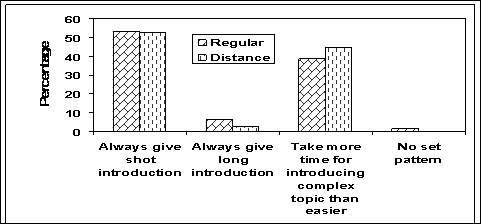| August 2009 Index | Home Page |
Editorís Note: This is a study of teaching effectiveness for student teachers trained in classrooms and in distance learning environments. The principal finding is that skills taught are different to the way they are used in actual classroom situations. There is a need for reexamination of the way teachers are tauight in initial training and in-service training.
Comparative Study of Teaching Skills of In-Service Teachers Trained through Regular and Distance Mode
Anupama Bhargava
India
Abstract
Effectiveness of a teacher in complex classroom situations has always been an area of interest for researchers. Subject matter expertise is not the only criteria that the effective teacher has to fulfill. Creating an environment in the classroom where reshaping and redesigning of knowledge, stimulation of intellectual curiosity, and innovative and independent thinking can take place, is a real challenge for teachers. To inculcate these attributes in teachers, teacher training programmes put utmost stress on developing skills among student teachers. During teaching practice, the novice student teacher uses teaching skills strictly per guidelines given by the teacher educator, but this state of affairs become different in real class room situations.
The present study is designed to take into account the comparison of in-service teachers trained by regular and distance mode with respect to use of teaching skills in the classroom. No significant differences are observed in use of skills of set induction, illustration with example, recapitulation, blackboard writing and use of teaching aids. Significant differences at the 5% level are observed in questioning and evaluation skills.
Keywords: Teaching skills, effective teacher, pre service training, micro teaching
Introduction
Prime aim of teachers has always been to help students to learn effectively and efficiently. To comply with this pursuit, teachers have to be proficient in the usage of various teaching skills in the classroom. One of the ways to maximize learning and to achieve the learning objectives is to understand the importance of individual skill and the integration of different skills. This holds true even more for teachers teaching in secondary classes where to keep students involved in the classroom, a teacher has to deal with topics in such a way as to motivate them in discussions, use questions to move ahead and interact, change the sensory focus with the help of teaching aids and, above all, summarize to help students learn. A thorough knowledge of subject matter is vital for imparting instruction (James & Choppin, 1977). In addition to this, systematic presentation of content matter is another requisite for teaching effectively. To bring forward the instruction in a logical sequenced manner, teaching expertise is essential. Even experienced teachers need to refine this aspect and add value to maximize the effect of teaching in the classroom (Sharma 2000).
Effectiveness of teacher behaviour can be judged through two approaches (Van der sijde & Tomic, 1989). The first approach requires finding out efficient use of learned teaching behaviour (skills) by school teachers. The emphasis is on the teachers. The second approach deals with outcome of such behaviour on the performance of students. Here onus lies on the effect of teaching on studentsí learning outcome.
The qualities of an effective teacher include one who is intellectually effective, uses various approaches while teaching and helps students to achieve high performance. These foremost teaching behaviors have been supported by Rosenshine & Frust (1971), Walberg & Haertal (1990), Good & Brophy (2004) and Borich (1988).
A teacher not only affects but also modifies the teaching-learning environment through personal factors like nature, interest, and code of conduct. Veldman & Peck (1963) have listed five prominent characteristics of an effective teacher: friendly and cheerful, knowledgeable and poised, lively and interesting, firm control and, above all, non-directive. Smith (2002) opined similar views that an effective teacher makes his classroom lively and full of activities. Kuhnís Process Product Paradigm (1970) also establishes a positive relation between teacher behaviour and studentís achievement in learning. Kwoklun & Lew (1981) revealed that an ideal teacher, besides having sound knowledge of the subject matter, has fluency of speech and is able to develop thought processe of students.
Relevance of teaching skills
Effective teaching skills are a precondition for translating theory into practice. Implementation of teaching principles in the classroom is facilitated with certain skills acquired by teachers through education and training. Farooq & Shahzadi (2006) revealed that students of trained teachers are better performers than students of untrained teachers.
Set induction, stimulus variation, questioning, illustration with example and closure are the essential teaching skills listed by Allen & Ryan (1969). Passi (1976) identified the following skills essential for a successful teaching: writing instructional objectives, introducing a lesson, questioning, explaining, illustration with example, stimulus variation, reinforcement, using blackboard, closure etc.
Verbal & non verbal expressions of a teacher (body language, facial expressions, and gestures) to facilitate learning are called Teaching Skills. These skills can be observed and measured in terms of a studentís change in behaviour (objectives realized). This implies that teaching skills are instructional techniques and procedures put to use by teachers to make teaching learning feasible by initiating two way communications between teacher and student. An insight of when and where to apply relevant and different teaching skills is the yardstick for a teacherís performance.
Role of pre service educational training in developing teaching skills
Anderson (1989) stressed the importance of an effective teacher training programme in inculcating skills among teachers. Pre service training modules facilitate teachers in understanding various theories of teaching/learning, subject matter, principles of curriculum construction, studentsí development and application of knowledge (Cooper, 2003; Moore, 2003 & Aggarwal, 1999).
Pre-service training programmes employ various approaches like simulation techniques, demonstration, interaction analysis and more notably, micro teaching to build up teaching skills among student teachers. These learnedt skills are reinforced during a teaching practice session while preparing lesson plans or teaching in the class room. Much value is attached to proper use & sequence of teaching skills. As a consequence of this constant drill, a student teacher makes headway in the class with set induction and reaches the closure by giving home assignments. This practice is adopted by both regular and distance mode teacher training programmes.
Microteaching is a skill oriented programme (where content takes a back stage). Intrinsic skills can be mastered by microteaching. Allen (1966) described microteaching as scaled down teaching in terms of content, class size and time.
In regular teacher training institutes to develop teaching skills, one skill is demonstrated at a time by a teacher educator and later on practiced by student teachers in reduced class size and time. Immediate feedback received from teacher and peer group help teachers to effectively adapt these skills. A re-teaching session, which is held after a time interval of an hour, strengthens the rectified behaviour. The integrated skill approach followed during teaching practice session later on becomes an irreplaceable part of teacherís behaviour in the classroom. Sachs (1999) put forth microteaching as an efficacious means to bridge the gap between theory and practice as more progressive and reflective approaches are adopted in teacher education.
Distance education teacher training programmes also lay emphasis on skill development among student teachers. For this, workshops are held during contact programmes. In such sessions, attendance of students is made mandatory. Teacher educators from a local college or experts from Distance University demonstrate various skills, this is followed by practice and preparation of micro lesson plans based on specific skills by student teachers. Instructions regarding steps followed in lesson plan are also imparted. These academic skills are acquired, sharpened and updated to make teaching learning more competitive Murthy (2008).
Objectives
Teaching learning is a complex process consisting of a host of activities to be performed by the teacher. To ensure understanding and assimilation of content matter by students, teachers use various skills. The main thrust areas of this paper are:
- To find out how teaching skills are used differently by the teachers in the classroom
- To investigate significance difference, if any, between teachers trained through regular and distance mode with respect to use of teaching skills.
- To examine improvisations made by teachers while applying teaching skills in the classroom.
Methodology
The present study is survey based.
Sample
The population under investigation included secondary school teachers. A sample of 100 secondary school teachers was randomly selected from eight schools of the city. Sixty-two (62) teachers were trained by regular mode and 38 through distance mode. Out of the 8 schools, 3 were Government, 3 were semi-aided and 2 were public schools. Forty-nine (49) teachers from Government Schools, 31 from semi-aided, and 20 teachers from public schools responded to the questionnaire.
- Government Schools: Schools that are run and managed by state government.
- Semi aided missionaries: Schools managed by Christian missionaries but semi aided from the state government.
- Public Schools: Schools managed by societies and trusts that have their own management and do not get aid from the central / state government.
Tools Used
Questionnaire
A questionnaire comprising of questions on seven skills practiced in the classroom was developed. To ensure content validity the draft was shown to colleagues who gave suggestions. Then it was applied to a sample of 5 student-teachers to assess the difficulty level and based on the feedback, the final version was prepared. Multiple choice questions were incorporated in the questionnaire and teachers were asked to tick the option being practiced by them more often in the class room. In case given choices didnít suit their methodology, blank space was given at the end of alternatives which could be used to write teacherís own preferred style. In the end, teachers were asked to write in two to three lines on classroom management skill.
Statistical Techniques
Cross tabulation analysis for two rows vs. four/ five columns was carried out by applying
Chi-square test to find out significance difference between teachers of regular and distance mode in application of teaching skills.
The Chi-square test was estimated on the basis of cell frequencies and whenever cell frequency is less than five, Yates correction method has been applied.
Results and Findings
In this research an investigation was carried out into the different kinds of skills used by student-teachers. The different teaching skills can be broadly classified in the following categories-
- Basic / fundamental skills: Set induction, illustration with example and blackboard writing are Basic or key skills. These skills form base for other skills which are used by teacher while teaching.
- Skill for interaction: Questioning is a skill which is required by teacher to make interaction and communication between teacher and student a two way process.
- Skills for assessment: Recapitulation and evaluation are the skills which are utilized by teachers to assess the achievement of teaching objectives in terms of studentís performance.
- Allied skills: To teach effectively and sustain interest in teaching learning environment, allied skills play crucial role. These include skills of using teaching aids and skills of classroom management.
The results pertaining to different skills are presented as follows: Figures in the tables given below denote cell frequencies. Figures in parenthesis are in percentage. Chi square test is based on cell frequency. ĎRí represents Regular mode and ĎDí represents Distance mode.
Skill of Set induction
Table-1 (a) depicts that 6.45 % of teachers (R) and 2.63 % of teachers (D) prefer giving long introduction, while 38.71% of teachers (R) and 44.74% of teachers (D) take more time to introduce a complex topic in comparison to an easier one. The value of Chi-square of 1.51 depicts no significant difference.
Table 1(a)
Skill of Set induction
| Always give short induction | Always give long introduction | Take more time to introduce a complex topic than an easier topic | No set pattern | Chi square test |
| |||||
Regular | 33.00 | 4.00 | 24.00 | 1.00 | 1.51 NS |
Distance | 20.00 (52.63) | 1.00 (2.63) | 17.00 (44.74) | 0.00 (0.00) | |
Total | 53.00 | 5.00 | 41.00 | 1.00 |
|
Figure 1a. Self Induction Skill
Table 1(b)
Skill of Set Induction
|
|
Use examples/ riddle/ story | Direct announcement of topic | No set pattern to introduce | Chi square test |
| |||||
Regular | 30.00 (48.39) | 19.00 (30.65) | 9.00 (14.52) | 4.00 (6.45) | 2.72NS |
Distance | 21.00 (55.26) | 11.00 (28.95) | 6.00 (15.79) | 0.00 (0.00) | |
Total | 51.00 | 30.00 | 15.00 | 9.00 |
Table-1 (b) depicts that 48.39 % of teachers (R) and 55.26 % of teachers (D) ask questions based on previous knowledge while 30.65 % of teachers (R) and 28.95 % of teachers (D) give examples/ riddle / story to introduce a topic.
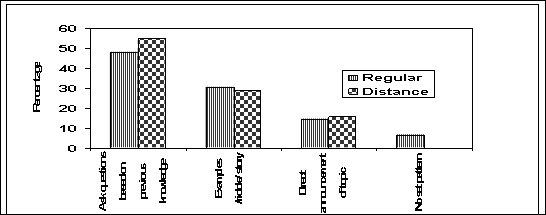
Figure 1b. Set Induction.
N.C.E.R.T has laid stress on many core teaching skills which include introducing lesson illustration with example, questioning, using teaching aids, use of blackboard, evaluation and management of class. Most of the trained teachers whether regular or distance mode use core teaching skills in the classroom. Marked differences in use of teaching skills are not prominent among teachers trained for regular or distance mode. In the present study, it is observed that 38.71 percent (regular) and 44.74 percent (distance) teachers take more time to introduce a complex topic in comparison to an easier one as shown in fig. 1(a). For majority of teachers i.e. 48.39 percent (regular) and 55.26 percent (distance), the chosen way of set induction is to ask questions based on previous knowledge as shown in fig 1 (b). This gives them scope to assess the understanding of students besides maintaining connectivity with previous chapter / content and helps in keeping the set induction short.
Skill of Illustration with examples
Table 2
Skill of Illustration with examples
| Give many examples | Donít give examples | Give examples only when required | No set pattern | Chi square test |
| |||||
Regular | 30.00 (48.39) | 7.00 (11.29) | 25.00 (40.32) | 0.00 (0.00) | 2.70NS |
Distance | 18.00 (47.37) | 2.00 (5.26) | 17.00 (44.74) | 1.00 (2.63) | |
Total | 48.00 | 9.00 | 42.00 | 1.00 |
Table-2 depicts that 11.29 % of teachers (R) and 5.26 % of teachers (D) donít give examples while teaching while 40.32% of teachers (R) and 40.32 % of teachers (D) give examples only when required.
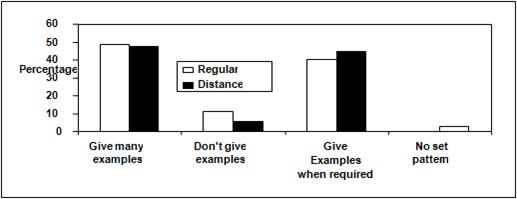
Figure 2: Illustration with examples
Skillful teachers take the help of examples to illustrate an idea, concept or principle. An example helps to engage studentís attention provided it is at his level of understanding. 48.39 percent (regular) and 47.37 percent (distance) teachers quote various examples in the classroom, while 40.32 percent (regular) and 44.74 percent (distance) teachers feel that examples should be given only when necessary as shown in fig.2.
Skill of Questioning
Table 3(a)
Skill of Questioning
|
|
| |||
| |||||
Regular | 9.00 (14.52) | 46.00 (74.19) | 4.00 (6.45) | 3.00 (4.84) | 0.92NS |
Distance | 7.00 (18.42) | 28.00 (73.68) | 1.00 (2.63) | 2.00 (5.26) | |
Total | 16.00 | 74.00 | 5.00 | 5.00 |
Table 3(a) depicts that 14.52 % of teachers (R) and 18.42 % of teachers (D) ask many questions in the classroom while 6.45% of (R) and 2.63 % of (D) prefers to not ask questions in the classroom.

Figure 3a: Questioning skill
Questioning is a tool to make the teaching/learning process more lively and participatory. It can transform the teaching learning/environment from the usual routine type to an intellectually charged one. It helps teacher in various ways, to stimulate thinking among students, check previous knowledge and sometimes to maintain discipline in the class. This skill becomes efficacious only when used in thoughtful manner when judging the classroomís state of affairs. Keeping this in mind, 74.19 percent (regular) and 73.68 percent (distance) teachers ask questions as per requirement of content/ topic/ classroom circumstance as observed in fig. 3(a). Questioning can be from students also in terms of enquiries/ doubts. When it is expected from students to reflect upon issues / topics, then it becomes prime duty of teachers to respond to their queries. 37.10 percent (regular) and 60.53 percent (distance) teachers are ready to answer anytime questions/ doubt asked by the students while 53.23 percent (regular) and 36.84 percent (distance) teachers specify that they prefer if students ask questions after finishing the topic as evident from fig 3 (b) .
Table 3(b)
Skill of Questioning
|
|
|
| No set pattern |
|
| |||||
Regular | 23.00 (37.10) | 33.00 (53.23) | 3.00 (4.84) | 3.00 (4.84) | 7.84* |
Distance | 23.00 (60.53) | 14.00 (36.84) | 0.00 (0.00) | 1.00 2.63) | |
Total | 46.00 | 47.00 | 3.00 | 4.00 |
Table-3(b) depicts that 53.23 % of teachers (R) and 36.84 % of teachers (D) give time for questioning only after finishing the topic while 37.10% of teachers (R) and 60.53 % of teachers (D) encourage students to ask questions any time. Here for this skill set a *Significant difference at 5% level is observed.
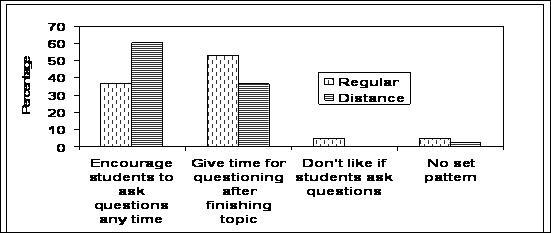
Figure 3b. Questioning Skills
Questioning skill can be used by the teacher to act as moderator during discussions or debates held in class. A significant difference at 5 percent level is observed (Figure 3b) among teachers of regular and distance mode in using this skill.
Skill of Recapitulation
Summarizing main points and retouching the complete topic in short is recapitulation. This helps in reinforcing the comprehension level of the students. 12.90 percent (regular) and 21.05 percent (distance) teachers recapitulate if time permits while 24.19 percent (regular) and 26.32 percent (distance) teachers improvise by combining recapitulation with evaluation as shown in Figure 4.
Table 4
Skill of Recapitulation
| Combine recapitulation with evaluation |
| ||||
| ||||||
Regular | 33.00 (53.23) | 8.00 (12.90) | 6.00 (9.68) | 15.00 (24.19) | 0.00 (0.00) | 1.44NS |
Distance | 17.00 (44.74) | 8.00 (21.05) | 3.00 (7.89) | 10.00 (26.32) | 0.00 (0.00) | |
Total | 50.00 | 16.00 | 9.00 | 25.00 | 0.00 |
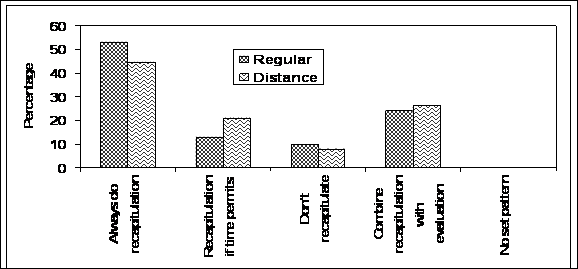
Figure 4. Recapitulation skill
Table 4 depicts that 53.23 % of teachers (R) and 44.74 % of teachers (D) always do recapitulate while 12.90% of teachers (R) and 21.05 % of teachers (D) recapitulate depending on the availability of time.
Skill of Evaluation
Table-5 depicts that 20..97 % of teachers (R) and 7.89 % of teachers (D) always ask oral questions while 24.19 % of teachers (R) and 15.79 % of teachers (D) evaluate on the basis of written work given in class. Here for this skill, a significant difference at 5% level is observed.
Table 5
Skill of Evaluation
|
|
|
|
|
| |
| ||||||
Regular | 13.00 (20.97) | 15.00 (24.19) | 34.00 (54.84) | 0.00 (0.00) | 0.00 (0.00) | 10.31* |
Distance | 3.00 (7.89) | 6.00 (15.79) | 25.00 (65.79) | 1.00 (2.63) | 3.00 (7.89) | |
Total | 16.00 | 21.00 | 59.00 | 1.00 | 3.00 |
To assess outcome of teaching in the form of student learning or understanding, teacher evaluates. A significant difference at 5 percent level is observed among teachers of regular and distance mode in using this skill. 54.84 percent (regular) and 65.79 percent (distance) teachers specify that they opt for evaluation in either written or oral form ( fig.5). Most of the teachers show flexibility and act as per context. Evaluation helps them to assess not only the cognitive but affective and psychomotor domain also.

Figure 5. Evaluation Skill.
Skill of Black board writing
Table-6 depicts that 14.52 % of teachers ( R ) and 10.53 % of teachers ( D ) writes main points on the black board , 29.03 % of teachers (R) and 26.32 % of teachers (D) write complete information and 45.16 % of teachers (R) and 55.26 % of teachers (D) write main points & tough words on black board.
Table 6
Skill of Black board writing
Use of teaching skills |
|
|
|
| No set pattern |
|
| ||||||
Regular | 9.00 (14.52) | 5.00 (8.06) | 18.00 (29.03) | 28.00 (45.16) | 2.00 (3.23) | 2.07NS |
Distance | 4.00 (10.53) | 3.00 (7.89) | 10.00 (26.32) | 21.00 (55.26) | 0.00 (0.00) | |
Total | 13.00 | 8.00 | 28.00 | 49.00 | 2.00 |
The blackboard is the most vital teaching aid in the classroom teaching. It not only helps in changing the sensory focus but also imparts correct information to the students. Use of blackboard depends on factors like class size, nature of the content, section (primary/secondary, senior secondary etc.). Irrespective of these, it has the status of most favored teaching aid by teachers. A total of 45.16 percent (regular) and 55.26 percent (distance) teachers write main points and tough words on blackboard (Figure 6).
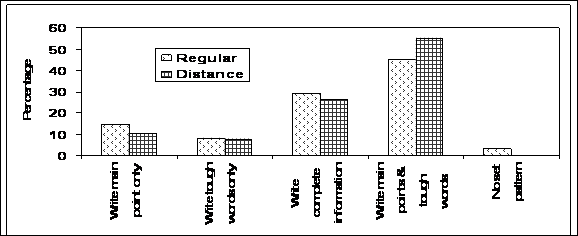
Figure 6. Blackboard writing skill.
Skill in using teaching aids
Table-7 depicts that 12.90 % of teachers (R) and 18.42 % of teachers ( D) always use teaching aids while 29.03 % of teachers (R) and 18.42 % of teachers ( D) do not use tTeaching aids.
Table 7
Skill of using teaching aids
| Always use teaching aids |
| Donít use teaching aids | No set pattern | Chi square test |
| |||||
Regular | 8.00 (12.90) | 31.00 (50.00) | 18.00 (29.03) | 5.00 (8.06) | 1.73NS |
Distance | 7.00 (18.42) | 20.00 (52.63) | 7.00 (18.42) | 4.00 (10.53) | |
Total | 15.00 | 51.00 | 25.00 | 9.00 |
Teaching aids not only help in capturing the attention of students but they make concept principles more clear and& self explanatory. 50 percent (regular) and 52.63 percent (distance) teachers use teaching aids only when available in school or they find it essential for a particular topic (fig.7). Teaching aids are not used by teachers on regular basis due to non availability resulting in their preferring the blackboard over other teaching aids. Some teachers believe that all the topics do not need teaching aids or simply because of not thinking on the lines that how a simple and small teaching aid could transform their classroom environment. For making use of teaching aids an integral part of classroom teaching, student help cn be usedd. Charts, models, clippings, power point presentations or simply a small speech related to topic or concerned issues prepared by students enrich their experiences and gives scope for creative expression.
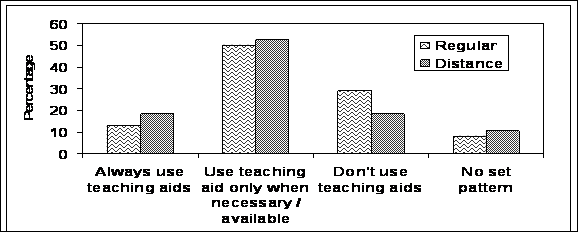
Figure 7. Use of Teaching Aids
Discussion and Suggestions
- Set induction can be based not only on what has been taught but also on what has to be taught. This can help teachers to distinguish between students as self learners and dependent learners.
- Student teachers are given theoretical and practical knowledge of teaching skills in teacher training programmes. During teaching practice session, they apply these skills in the same sequence and style as demonstrated by the teacher educator. As a result, the whole process becomes very mechanical, monotonous and takes place in laboratory-like conditions. While instructing student teacher about various skills, the approach must be flexible. During teaching practice, skills should be practiced by the student teacher as required in real classroom settings.
- Teachers whether trained by regular or distance mode make various improvisations in using teaching skills. This is a practical aspect of classroom teaching. Due to heavy workloads, compulsion of covering the syllabus within a given time limit and overcrowded classes, teachers tend to combine certain skills like evaluation and recapitulation or overlook some skills like use of teaching aids. Experimentation, creativity and innovation do not find priority in the teaching practice of most of the teachers.
- Recapitulation and evaluation are integral part of teaching behaviour in the class. If, in a given period, teacher is unable to use these skills, in the next class these can be used as a set induction to introduce a new topic.
- Science and math teachers use the blackboard for drawing diagrams, writing formulae or solving problems. In language or social science classes, a picture, scene or mood related to content matter drawn on blackboard can be used to capture interest, stimulate thought process and promote divergent thinking.
- As per Ur (1996): Classroom discipline refers to a state where both teacher and students accept and follow a code of conduct to facilitate smooth, efficient teaching and learning in the class. ĎA well-prepared content matter with interesting examples is the foremost condition for managing class wellí is the view point of the majority of teachers. Some teachers use questioning skills to keep students attentive in the class. Seating arrangement (i.e. not allowing all the impish students to sit together), is another way to maintain discipline in the class. Using easy language, involving students in various activities like group work, using teaching aids, written assignments and giving every one chance to speak or answer in the class help in effective classroom management.
Conclusion
Teaching skills are imperative for teachers as the means to fulfill the ultimate aim of bringing positive and desired change in the cognitive and affective domain of the students. All the teaching skills are interrelated and influence one another. The way teaching skills are learned and practiced in teacher training institutes remain different from the style in which teachers use them everyday in the classroom. The difference between the two needs to be minimized. Effectiveness of a teacherís teaching behavior is determined not by number of skills she uses in the class, but depends on how these skills are interwoven, adjusted and refashioned to make pedagogy an effective tool in putting students in the mould of active learners, explorers and thinkers. Updated pre service and in service programs can act as suitable vehicles to achieve the desired goal.
References
Aggarwal, J.C.(1999). Development and planning of modern education, New Delhi : Waqas Publishing
Allen, D.W. (1966). Microteaching a description. Stanford University School of education.
Allen, D.W., Ryan, K.A. (1969). Microteaching reading mass: Addison ĖWesley.
Anderson, L.W. (1989). The effective teachers, Study guide and reading, New York : Random House
Borich, G.D. (1998). Effective teaching method. New york : Merill Publishing Company.
Cooper, M.J.(2003). Classroom teaching skills. Bostan: Houghton Mifflin
Farroq, M.S. & Shahzadi, N.(2006), Effects of teacherís professional education on studentís achievement in mathematics. Bulletin of education & research 28(1).PP. 47-55.
Good , T.L. & Brophy, J.E (2004): Looking in the Classroom. Boston : Allyn & Bacon
James, G. & Choppin, B. (1977). Teachers for tomorrow, Educational research: 19, 184-191.
Kuhn, T.S. (1970), Structure of scientific revolution, Chicago: University of Chicago Press
Kwoklun, C. & Lew, J.F. (1981).The criteria of teacher competence as perceived by students, student teachers and serving teachers in Hong Kong: CUHK Education Journal, Vol.9, No. 1.
Moore, K.D. (2003), Classroom teaching skills. Mexico city : Mc Graw company
Murthy, G.S. (2008). ĎAcademic skills of teachers for student performanceí: Rajat Publications, New Delhi, India
Passi, B.K. (1976). Becoming better teachers. Baroda: Centre for advanced study in education, M.S. University of Baroda, 1976.
Rogers, B.W & Hamil B.W. (2008). The first year teacher in a critical needs school : Teaching the content area or solving studentís problems ? National forum of teacher education Journal, Volume 18, No.3.
Rosenshine, B & Frust, N (1971). Research in teacher performance criterion. Englewood Cliffs : Prentice Hall.
Sachs, G.T. (1999). Pre service teacher development through a more dynamic approach to microteaching, Hongkong journal online, Vol. II, Perspective (City University of Hongkong).
Sharma, S.R. (2000). Modern teaching strategies, New Delhi: Omsons Publications.
Smith, R.(2002). Effective primary school a guide for school leaders and teachers. London : Kogan Page Limited.
Tomic, W. (1991). Training programs in research into effectiveness of teacher behaviours : Journal of education for teaching, Volume 17, No.2.
Ulaah, S.Z.& Farooq. R.A.(2008). Effectiveness of teacher education programmes in developing teaching skills for secondary level. Journal of Quality and Technology Management, June 2008 issue.
Ur. P.(1996), A course in language teaching : Practice & Theory, Cambridge university Press.
Vander sijde, P.C.& Tomic, W.(1987). Design of training programmes for teachers based on the results of Research, Education & Society, 5,PP.37-48.
Veldman, D.J. and Peck , R.F. (1963). Student teacher characteristics from pupils viewpoint, Journal of educational psychology, 54, 346-355
Walberg, H.J. & Haertal, G.D. (1990). The international encyclopedia of education evaluation, New York Pergaman Press
